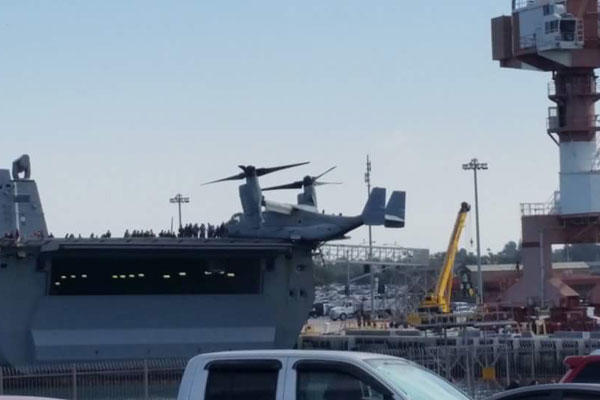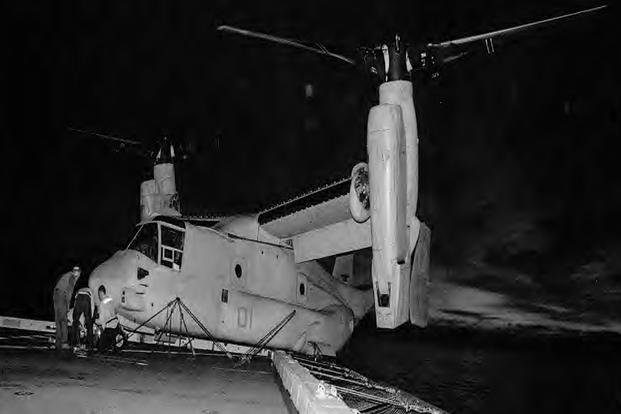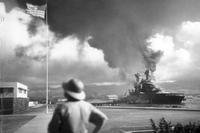The aircraft's call sign was "Lucky 11." And it turned out to be well-named.
On Dec. 9, 2015 -- a year ago last Friday -- the MV-22 tiltrotor aircraft landed short on the amphibious transport dock New Orleans, coming to a stop with barely half the Osprey safely on the ship's flight deck.
Miraculously, none of the 22 Marine passengers and four crew members aboard was hurt and all were able to exit the aircraft unharmed before the ship docked in San Diego to assess the damage.
The mishap happened while the New Orleans and the two other ships in the Boxer Amphibious Ready Group were conducting a pre-deployment certification exercise off the coast of southern California.
An investigation, obtained by Military.com, shows the short landing was the result of a "series of judgment errors," beginning with a weight miscalculation for the aircraft that altered its speed as it approached the New Orleans' flight deck. The results of the investigation were first reported by Marine Corps Times.
The pilot and co-pilot of the aircraft, both captains whose names were redacted in the investigation, were held at fault for the mishap and placed on conditional flight status in January, forcing them to conduct retraining before resuming deck landing and aircraft commander operations and duties.
However, a flight performance board found both officers were above-average aviators who showed poor judgment in flying the aircraft near its maximum weight limits but had not shown gross negligence or violation of aviation regulations.
"This incident is the only negative performance issue for either officer," wrote 13th Marine Expeditionary Unit Commander Col. Anthony Henderson in an endorsement of the board's findings. "It is my belief they will not have such an incident again in the future and will continue to perform at a high level."
The mishap occurred at the end of a day of flying. Lucky 11 made a stop on the amphibious assault ship Boxer, the lead ship in the amphibious ready group, to fuel up. The aircraft took on 9,000 pounds of fuel, with the pilot expecting it would depart the deck with 8,400 pounds, allowing for fuel burn with 20 minutes of idling. That was a large fuel load, and the aircraft was already heavier than anticipated, due to a miscalculation in passenger weight. Investigators would find the aircraft was 500 pounds heavier than it should have been to make the flight from the Boxer to the New Orleans, according to standard operating procedure.
Around 5 p.m., the Osprey made the approach to the New Orleans. The aircraft was coming in a little low, observers said, and about 20 horizontal feet from the edge of the flight deck, the aircraft, which lands like a helicopter, lost forward progress, the investigation states. The pilot and co-pilot decided to apply more power and "make a play" for the flight deck, since they were so close and hadn't been waved off.
As the Osprey touched down, its landing gear became entangled in the safety nets at the front of the deck, and it jerked around because of the late application of power.
One of the crew members saw that the aircraft was caught in the nets and reported this to the pilot and co-pilot. Both officers immediately thought of a horrific 1999 incident in which a CH-46 chopper attempted to land on the USNS Pecos, a replenishment oiler, and became entangled in the deck fence. In that aircraft's efforts to extricate itself, it rolled off the deck and plunged into the water, resulting in the deaths of seven of the Marines aboard.
With this in mind, the pilots made efforts to keep the Osprey on the deck, tilting the aircraft's nacelles forward to move its center of gravity forward.
Investigators would later say the pilots' memory of the Pecos incident and the actions they took as a result may have saved the aircraft.
More training was needed fleet-wide, investigators determined, to ensure Osprey pilots know how the aircraft handles at maximum gross weight. They also recommended that the Marine Corps develop radio frequency identification (RFID) tags for Marines that would assess their weight with all their gear and make it simpler for aircrew to create accurate flight manifests.
-- Hope Hodge Seck can be reached at hope.seck@military.com. Follow her on Twitter at@HopeSeck.




























